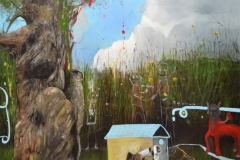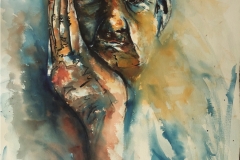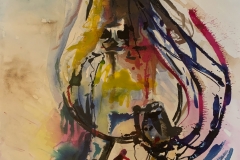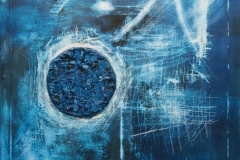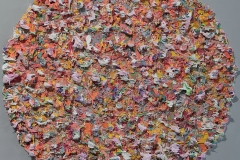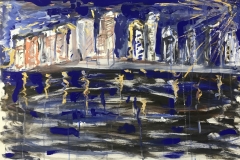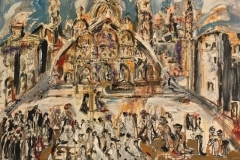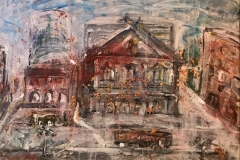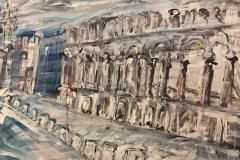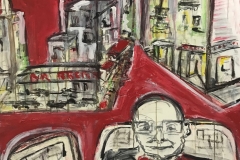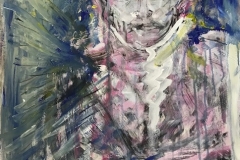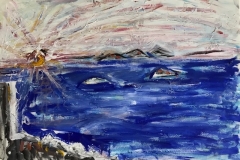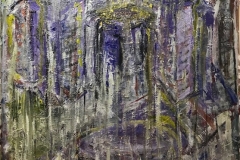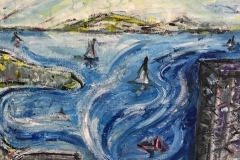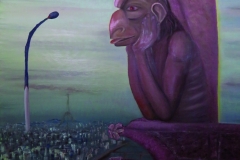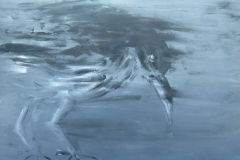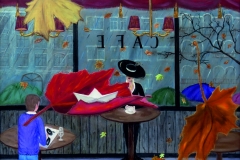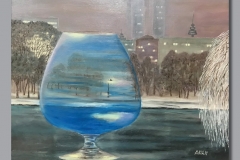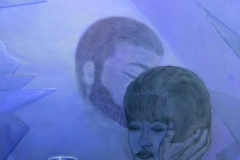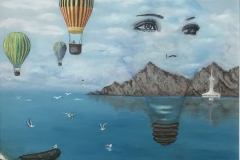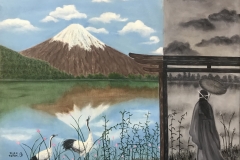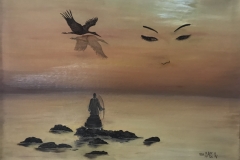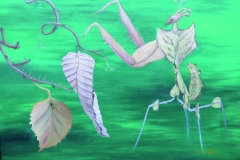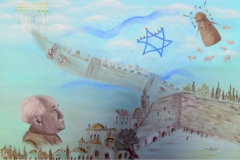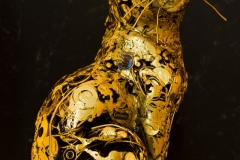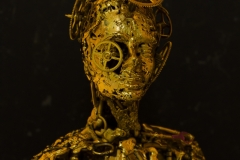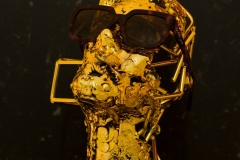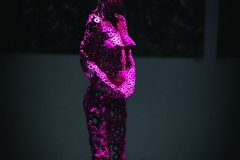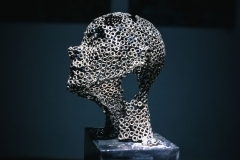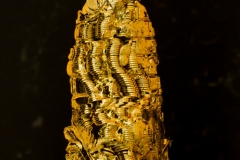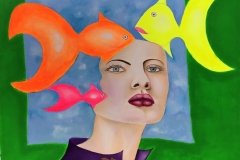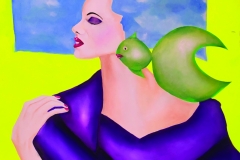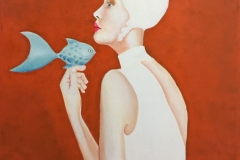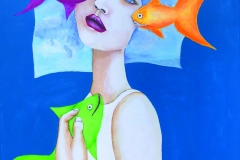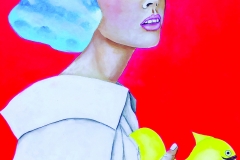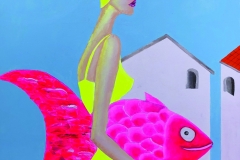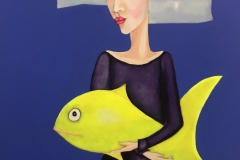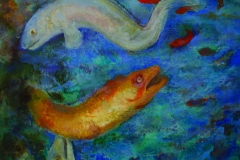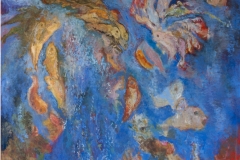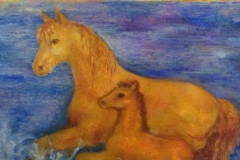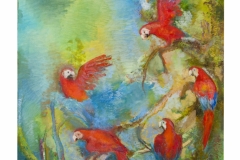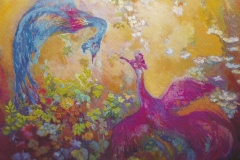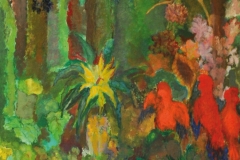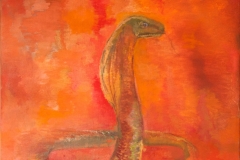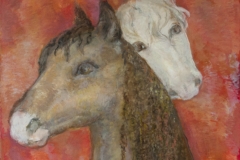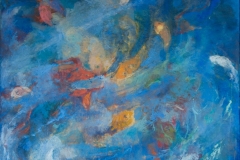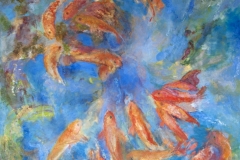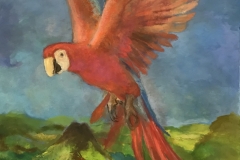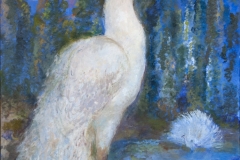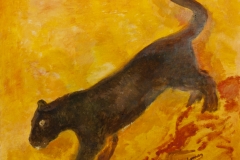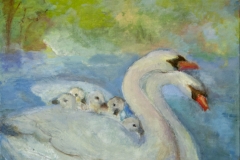JOSÉ LUIS RAMIREZ
SEMBLANCE OF THE ARTIST
Originally from the city of Durango, he graduated from theSchool of Painting, Sculpture and Crafts of the UJED. His art is inspired by the constant changes in the social life where he lives, making his work fun, questioning, transgressing, and playing to create bridges between reality and fiction.He has participated in artistic projects of the FONCA and made four murals in the native land: “Mexican Historic Landscape” in the Public Central Library “José Ignacio Caballero”, “New Earth” in the Public Central Library, “El Tiempo, la sombra y el Cobijo” in the Central Building of the UJED, “The Pending Rights” which stands on the walls of the local State Congress. His work has been exhibited in various countries with more than 60 individual and collective exhibitions.
PILAR OSTOLAZA
Pilar Ostolaza Watercolors swim in the metaphysics of creation and life… a mirror of one’s own character. Let it be unpredictable, joyful and colorful.
Pilar effects of watercolour pigment freezing in layers on top of each other, the pooling of pigment at the edges of brush strokes and frost patterns all remain in the painting if sublimation can take place.
Water supports all our endeavors, from the simple task of making paint flow, to sustaining life. It is the common denominator that all humanity shares.
SUSANA ANAYA
Every color has an emotion for me; when I start mixing my own colors, I feel their energy… I am able to see the unconscious,” says Susana Anaya. This Mexican artist follows the path of abstract expressionism, and many of her works reveal the principles embodied in the works of Mark Rothko, Jackson Pollock, Cy Twombly and Barnett Newman. Russian and then American authors of the twentieth century consistently freed painting from the narrative. As such, painting has become closer to music or poetry: after all, neither music nor words depict anything; however, they express a lot. The language of abstract painting speaks directly to figurative perception and helps to feel the same as the artist felt. Despite the fact that Susana presents herself as a self-taught artist, the arrangement of elements in her works does not contradict the classical laws of composition. The artist finds balanced proportions of geometric forms. The selection of colors, their combinations are harmonious and balanced: even open colors do not carry excessive brightness or aggression. Susana combines various techniques, and her experience as a sculptor gives her works a special plasticity. It turns out to be surprisingly deep, shimmering and enchanting surfaces. Watching them is akin to filling anti-stress coloring books – infinite, complex and soothing. Is contemporary art able to help in setting up an emotional connection, to decorate the environment around a person and remain modern?
Alexandra Konshakova.
DONATELLA LANZENI
La expresividad y el gesto de Donatella Lanzeni
Donatella Lanzeni pinta Milán con la expresividad efusiva de la artista pintora que busca el gesto, la salpicadura, el color, la impronta de lo que es por sí mismo, potenciando la escenificación de edificios, monumentos históricos, catedrales, plazas, aspectos urbanísticos de clara determinación arquitectónica pero yendo más allá de la anécdota.
Artista italiana internacional, vive Milán por dentro con intensidad, dado que interioriza la ciudad transalpina para interpretarla, pero también pinta ciudades y aspectos urbanos de Alemania, Estados
Unidos y Gran Bretaña, entre otros países, exponiendo en diferentes y variadas ocasiones especialmente en América, Asia y Europa.
Posee una variada técnica fruto de su experiencia con pintores y artistas, maestros de la pintura que contacta en Milán, trabajando en multitud de técnicas, técnicas mixtas, acuarela, pastel y óleo especialmente.
Posee un claro planteamiento espacial en sus composiciones urbanas, destacando por la expresividad del gesto en lo representado, buscando una cierta simplificación maximalista dentro de un contexto en
el que la composición y la materia ocupan un lugar determinado en muchos aspectos destacado.
El gesto hace que la composición cobre vigor y vida, buscando expresar la fuerza de la impronta del momento.
Huye de la estructuración, de la estratificación, porque considera que toda formalidad es parte de una estructura que en el fondo no se corresponde con la realidad. Esta va más allá de la materia, y de ahí
que sus formas sean expresivas, porque buscan y exhiben la técnica del gesto en la dinámica del color, que muestra todo su potencial energético sin cortapisas.
Es una artista libre, veloz, que trabaja con la vista puesta en el más allá de la forma que observa y siente, partiendo de aspectos concretos de una realidad que nos exhibe su atracción.
A pesar de que parte de la realidad que precisa vivir y ver, su obra pictórica posee una cierta disposición al símbolo, porque resume en rápidos gestos y pinceladas aspectos formales de la composición urbana y arquitectónica de los edificios y monumentos que encierran alegorías simbólicas insinuadas que no acaban de mostrarse pero que deja intuidas, para que el espectador disfrute de la posibilidad de una segunda lectura o hasta de una tercera lectura de un mismo planteamiento, pero que se engrandece si miramos todos sus ángulos.
En sus paisajes urbanos de Milán la artista italiana, a través de las distintas técnicas que domina, exhibe aspectos diferentes de un mismo planteamiento, mostrándonos la posibilidad de viajar en el espacio-tiempo, instalándonos en una contemplación de su obra que va más allá de lo que se reproduce.
Joan Lluís Montané
De la Asociación Internacional de Críticos de Arte (AICA)
IRINA MARKOV SHAGAL
Irina Markov-Shagal is able to wrap the reality in symbolic forms; her works combine carefully painted details and the general
artistic convention into a single composition. She manages to mix seemingly uncombinable styles. To deliver her message, the
artist sometimes deliberately violates the laws of isometry, thereby only emphasizing and reinforcing the significance and
supremacy of the philosophical idea. Irina’s paintings are very recognizable, and the viewer can always trace the subtle, but
forever perceptible threads of kinship with her great ancestor, Marc Chagall. Here is her verse dedicated to the artist, which
probably explains the source of her talent: “And I carry the same genes that Mark had. And I promise: I will find his ideal no
matter what.”
“My paintings do not imply a descriptive side, but I try to put a certain philosophical idea into each of them,” says Irina. The
colors help to catch the spirit, and the depicted objects and characters are to reveal the inner meaning of a work. According to the
artist, her ideas are universal, and anyone, regardless of language, age or life experience, can understand them and embrace her
feelings. However, realizing that everyone’s perception is individual, Irina is happy when a viewer, evaluate her work, finds a
deeper background and meaning in a painting than she put in it.
To be closer to the viewer, most of the time Markov-Shagal even paints not with the help of intermediary tools, but right with her
fingers, thereby transferring the energy of her hands to the paintings. Many of her admirers really feel the positive energy coming
from her works: it envelops and charms. All because Irina possesses a special aura, with which she can help people to cure
diseases, if not particularly heal them. Although she treats her gift with self- irony and is clearly embarrassed to talk about it,
nevertheless, she regards her work as creative and constructive. The artist well known like a “goodwill ambassador” who is able
to connect countries and nations with something higher than politics.
Indeed, Irina Markova-Shagal has already become a phenomenon of the Russian-Israeli relations. On February 24, 2019, she
received a medal for achievements in the culture and art of the Creative Union of Culture Workers of the Russian Federation, as
well as a diploma of an honorary member of the Russian Creative Union. Negotiations are underway about Irina leading the
branch of the Russian Creative Union in Israel. The artist promises to work for the benefit of the two countries: Russia and Israel.
Irina have been named the Goodwill Ambassador more than once. She also start her personal way in diplomacy with Arab
countries The artist presented her paintings in the United Arab Emirates, at the International Art Fair in Dubai on April 2019 and
in Qatar at the International Art Festival in Doha on November 2019.
Text Alexandra Konshakova, from Hermitage Museum,
(St. Petersburg).
WILL YAYA
In his new series of works, Will Yaya combines different materials: silver, tin, zinc; if you look closely, you can distinguish coins, nuts, scrolls, screw-nuts, and many other items. conceptual surreal contemporary art : the surface flickers mysteriously, geometric shapes flow into soft amorphous droplets; the play of warm and cold shades of metal attract the eye. But if you overcome the charm of the material, you can discover the tragic content of the works. The very technique of their execution – chaotic, multi-layered, fragmented – suggests the artist’s impressions of reality, where the events are constantly replaced, superimposed on each other.
Will takes the image of beautiful strong animals such as Gorila, elephant and a rhinoceros as a basis – and makes them literally disappear in front of the viewer. As in ancient myths, the world is being held on the back of a giant creature, only a modern artist cannot fail to notice how the human world – a city – putting roots down in nature, destroys it, literally eats it away from inside. The play with mythology calls to pay attention to environmental issues.
In the same series of sculptures, Will creates portraits of humanity. These are eerie and at the same time attractive masks with blurred features, similar to ancient idols. Each head is crowned with a “crown”, similar to a tower with intertwined animal bodies. There is an association with the Tower of Babel – a symbol of human pride. It is worth noting that coins are one of the building materials for Will Yaya in the buildings of these crown-towers. Does the artist hint that money has become the cornerstone in the creation of the modern human?
Using ancient myths and different metals, Will Yaya creates unique sculptures with reflection on the burning themes of reality.
Art critic Alexandra Konshakova
Translated by Euginia Alimova
ALEXANDER YAYA
Fish Tank
The composition “Fish Tank” is a large decorative panel that could serve as a sketch for a truly monumental piece
or graffiti. A juxtaposition of a soft background gradient and a mosaic of small colored spots in the center means
each color finds support in the background. The background is static, while the silhouettes of the fishes are filled
with complex shapes and variations of shades. Such diversity creates the effect of movement, so the fish become
literally iridescent as though covered by a real coat of scales. The two round shapes and two sickle lines remind us
of the phases of the moon: a full disk, a crescent. Interestingly, ancient cultures such as Assyrian actually identified
the moon with fish, and modern fishermen still believe it to affect their catch. And lest we forget the moonfish,
that swims in the waters of the Pacific Ocean… So the picture is capable of bringing diversity to the interior, and to
prompt interesting associations.
For example, the Petersburg poet Olga Vasilevskaya thinks the spots on the fish remind her of the landscape of a
modern metropolis, with yellow street lamps and blue shadows of skyscrapers. The sci-fi “cities” in the sky glow,
whereas the huts below are immersed in darkness. “Well,” the poet muses, “apparently, it is worth going beyond
the frame of the familiar world to watch nature (or at least raise your eyes to the sky): only in this way you can see
miracles.”
Magic Night of the Fish
Optical illusions have always been one of the favorite techniques of artists irrespective of nationality and century.
Dutch artist Maurits Escher is one of the most prominent figures in this field. His famous works
fish silhouettes turn to birds, melting into the darkness… Magic Night by Alexander Yaya builds on the same
technique. The fish seem to be elevated above the background at one moment, and cut out of it at the next. Our
brain tends to see the whole picture (Gestalt) at first, and its constituents afterwards. Because of this effect, we
perceive the fish as existing in space at first glance, and only then start to see the background with the fish-shaped
piece cut out of it. By the way, how quickly will the viewer notice that the girl with the pink hair, like Ariel the little
mermaid, is also an illusion? She serves a fish tank for the green and orange sea creatures that swim past and
disappear behind the obscure misty curtain. Simple magic at work.
Art Critic Aleksandra Konshakova
Saint-Petersburg
MERCEDES CASTRO LOMAS
Mercedes Castro is an artist from Madrid. She is a painter who enjoys her work and captures life beyond the external. It is characterized by the mastery of color, the unfathomable expressivity of its chromatisms and scenarios, full of exuberant vegetation, with the presence of the strength and passion of people, animals, forest spirits, devas and energies. It connects with force the nature, with the determination of the existence, but, also, with the enigmatic thing, with light, balance, the search of the energy and the magnetism in very cared environments, forests, plants, flowers, symbolic animals and determinants like the rooster, the cat or the peacock.


